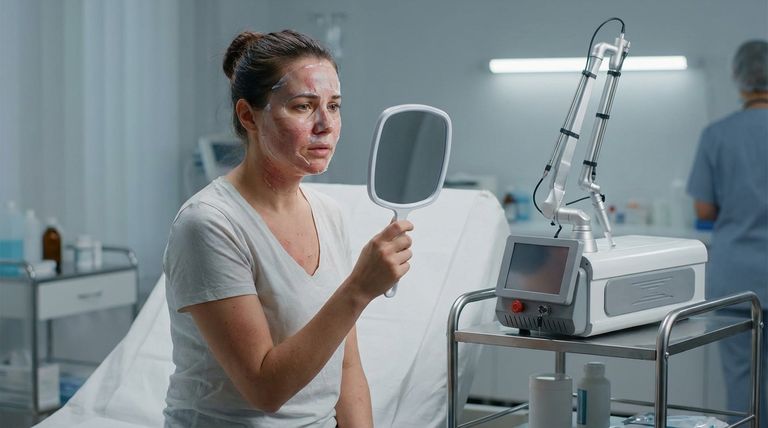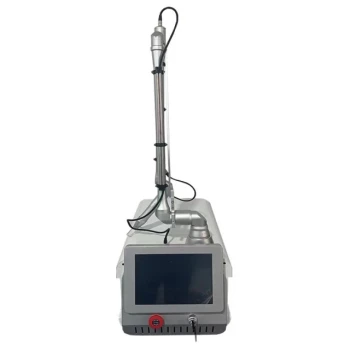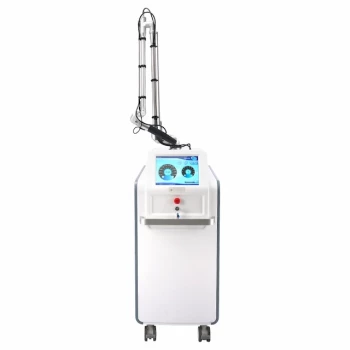The primary disadvantages of fractional CO2 laser treatment are its significant downtime and a clear set of potential risks. Patients must anticipate a recovery period involving swelling, redness, and discomfort, alongside potential complications such as infection, changes in skin color, and, in rare cases, scarring.
While fractional CO2 laser is a highly effective skin resurfacing tool, its power is a double-edged sword. The main disadvantage isn't just the risk of complications, but the certainty of a demanding recovery period that must be planned for and managed correctly.

The Reality of Post-Treatment Downtime
Before considering rare complications, it's critical to understand the expected recovery process, which is the most immediate disadvantage for most patients. This is not a "lunchtime" procedure.
The First Few Days: The Intense Phase
Immediately following the treatment, the skin will be raw, swollen, and red, similar to a severe sunburn. You will experience a burning sensation, itching, and general discomfort. This initial phase requires intensive post-procedure care.
The First Week: Peeling and Healing
The skin will begin to peel and flake as the old, damaged layers shed to reveal the new skin underneath. It is crucial not to pick at the skin during this time to prevent scarring and infection.
Weeks Two to Four: Persistent Redness
While the initial discomfort and peeling subside after about a week, a noticeable redness (erythema) can persist for several weeks or even months. This cosmetic issue is a significant drawback for those unable to take extended time away from social or professional commitments.
Potential Risks and Serious Complications
Beyond the standard recovery process, there are specific medical risks that, while less common, must be understood before consenting to treatment.
Changes in Skin Color
The laser can trigger changes in pigmentation. Hyperpigmentation (darkening of the skin) is a more common risk, especially for individuals with darker skin tones. Less frequently, hypopigmentation (lightening of the skin) can occur.
Infection
The treatment creates thousands of microscopic wounds in the skin, temporarily compromising its protective barrier. This makes the area vulnerable to bacterial, viral, or fungal infections if post-care instructions are not followed meticulously.
Acne and Milia
The heavy ointments and creams required for healing can clog pores. This can lead to acne breakouts or the formation of milia, which are tiny white bumps on the newly healed skin.
Scarring
Though rare, scarring is the most severe potential complication. It is more likely to occur if the patient has a history of keloid scarring, if an infection develops, or if post-treatment care instructions (like avoiding sun exposure and not picking at the skin) are ignored.
Understanding the Trade-offs
The decision to undergo fractional CO2 laser treatment is a balance between desired results and tolerance for risk and recovery. The procedure's aggressiveness is precisely why it delivers dramatic results for issues like deep wrinkles and severe sun damage.
Candidate Suitability is Key
Not everyone is an ideal candidate. The risks, particularly for pigmentation issues, are significantly higher for individuals with darker skin phototypes (Fitzpatrick types IV-VI). A consultation with a board-certified dermatologist is essential to evaluate your specific risk profile.
The Practitioner's Skill Matters
The experience and skill of the person performing the laser treatment are paramount. An inexperienced operator can increase the risk of all adverse outcomes, including uneven treatment and scarring. This is not a procedure where you should look for the lowest price.
Making the Right Choice for Your Goal
To decide if the disadvantages are acceptable, you must align the treatment with your specific goals and lifestyle constraints.
- If your primary focus is correcting deep wrinkles or significant acne scarring: The downtime and risks of fractional CO2 may be a worthwhile trade-off for its unparalleled results.
- If you have a darker skin tone or a history of hyperpigmentation: You must prioritize finding a provider with extensive experience treating skin of color to minimize the high risk of pigmentation changes.
- If you cannot afford 7-10 days of social downtime: You should consider less aggressive treatments like microneedling, radiofrequency, or non-ablative lasers, which offer more gradual results with minimal recovery.
Ultimately, an informed decision comes from a clear understanding that the path to dramatic skin rejuvenation involves a period of significant, unavoidable healing.
Summary Table:
| Disadvantage | Key Details |
|---|---|
| Significant Downtime | 7-10 days of social downtime; redness can persist for weeks. |
| Skin Color Changes | Risk of hyperpigmentation (darkening) or hypopigmentation (lightening). |
| Infection Risk | Microscopic wounds make skin vulnerable to bacterial/viral infection. |
| Scarring | A rare but serious complication, especially with poor aftercare. |
| Acne & Milia | Heavy healing ointments can clog pores, causing breakouts. |
Make an informed decision for your clinic or salon. The power of fractional CO2 laser requires expert handling to maximize results and minimize risks for your clients. BELIS specializes in providing professional medical aesthetic equipment and comprehensive support to medical aesthetics clinics and premium beauty salons. Ensure your treatments are safe and effective with technology you can trust.
Contact our experts today to find the right laser solution for your business needs and client profiles.
Visual Guide

Related Products
- Fractional CO2 Laser Machine for Skin Treatment
- Fractional CO2 Laser Machine for Skin Treatment
- Pico Picosecond Laser Machine for Tattoo Removal Picosure Pico Laser
- Pico Laser Tattoo Removal Machine Picosure Picosecond Laser Machine
- EMSlim RG Laser Body Sculpting and Slimming Machine
People Also Ask
- What will my face look like after a CO2 laser? Your Complete Recovery Timeline
- Who is not suitable for CO2 laser? Key Risks for Darker Skin & Active Conditions
- Is CO2 laser for all skin types? A Critical Guide to Skin Type Safety and Risks
- What are medical lasers used for? Precision Tools for Surgery and Skin Treatments
- What is a fractional CO2 laser machine used for? A Guide to Advanced Skin Resurfacing



















